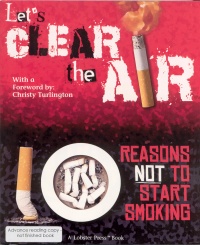| ________________
CM . . .
. Volume XIV Number 3 . . . .September 28, 2007
excerpt:
Let's Clear the Air is a collection of stories and essays by people, age 9-17, about smoking, and why the young authors choose not to smoke. A brief history or description of each author accompanies their writing. The stories and essays vary significantly in their style and content, but they are generally 1-3 pages long. The youths writing the essays include anti-tobacco youth activists, kids who have smoking family members, and some that have lost family members to tobacco-related illnesses. The writings tend to be personal, straightforward and heartfelt. A huge success of this collection is its ability to go far beyond health related reasons not to smoke. For youths who feel invincible, or who are unconcerned with health, the book offers 10 unique reasons not to smoke, including sports performance, appearance, environmental sustainability, financial cost and false advertising/supporting tobacco corporations. Each chapter is dedicated to one reason and contains the youths' writings, as well as examples of anti-smoking advertising, and fact boxes. A vital part of the book, the fact boxes share a variety of types of information with readers. 'Activist Moments' shares successful and ongoing actions that youths and adults have accomplished in anti-smoking campaigns. These range from nine-year-old Justin Kvadas who succeeded in getting smoking banned in cars carrying children under age seven to a laryngectomy patient who smoked through a hole in her neck in a memorable anti-smoking TV advertisement. 'Fast Facts' are brief informational blurbs, often containing statistical information. They focus on anything from the amount of advertising cigarette companies aim at young people to why cigarette filters do not work. 'Smoking Stats' offer very brief statistics on death and disease rates, the appearance of tobacco in entertainment and other topics. 'Did You Know?' boxes share surprising and unusual information, such as the fact that cigarette butts are often accidentally consumed by marine animals and birds, and that smoking may contribute to the development of agoraphobia and panic disorder. Historical information written about in "Instant History Facts" gives context to anti-smoking struggles and reveals information that may seem shocking to young readers- that smoking was permitted in airplanes everywhere until 1988, and that the first U.S. study on tobacco's link to cancer and other illnesses was only released in 1964. The fact boxes serve to break up the essays and stories, adding visual interest to the book, and increasing the ease in which the book may be read. Highly Recommended. Reece Steinberg, a librarian at Vancouver Public Library, currently works in the Business & Science, and Virtual Reference divisions.
To comment
on this title or this review, send mail to cm@umanitoba.ca.
Copyright © the Manitoba Library Association. Reproduction for personal
use is permitted only if this copyright notice is maintained. Any
other reproduction is prohibited without permission.
NEXT REVIEW |
TABLE OF CONTENTS FOR THIS ISSUE
- September 28, 2007.
AUTHORS |
TITLES |
MEDIA REVIEWS |
PROFILES |
BACK ISSUES |
SEARCH |
CMARCHIVE |
HOME |
